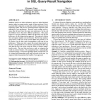53 search results - page 8 / 11 » Automatic malware categorization using cluster ensemble |
SIGMOD
2007
ACM
14 years 7 months ago
2007
ACM
Database queries are often exploratory and users often find their queries return too many answers, many of them irrelevant. Existing work either categorizes or ranks the results t...
LREC
2008
13 years 9 months ago
2008
We address here the need to assist users in rapidly accessing the most important or strategic information in the text corpus by identifying sentences carrying specific information...
TAL
2004
Springer
14 years 27 days ago
2004
Springer
Word fragments or n-grams have been widely used to perform different Natural Language Processing tasks such as information retrieval [1] [2], document categorization [3], automatic...
ICDE
2003
IEEE
14 years 9 months ago
2003
IEEE
Analyzing sequence data has become increasingly important recently in the area of biological sequences, text documents, web access logs, etc. In this paper, we investigate the pro...
GECCO
2009
Springer
14 years 5 days ago
2009
Springer
Radiologists disagree with each other over the characteristics and features of what constitutes a normal mammogram and the terminology to use in the associated radiology report. R...

